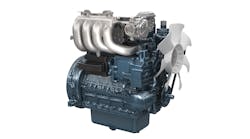What Turbochargers & Catalytic Converters have in Common
By: Scott Strong, national manager, Global Aviation Services LLC
A recent issue in one of our shops has pointed out yet another area of the maintenance side of our business that is changing. Catalytic converters have been installed on some medium- and heavy-duty trucks since as early as 2001, but with the tightening federal emission standards, they have been installed on most medium-duty trucks since 2006. As of now, equipment manufacturers are producing airstarts and GPUs equipped with catalytic converters on their diesel engines as well. While the fact that a catalytic converter by itself does not change how we repair the equipment, we need to keep in mind how a turbocharger failure can cause expensive, avoidable and irreparable damage to a catalytic converter.
Our customer had an oil seal fail on a turbocharger on a 6.0l powerstroke engine recently, which dumped copious amounts of oil into the intake. That oil ended up exiting the exhaust manifolds and promptly deposited itself into the cat, where it not only produced extreme temperatures and began to melt the internal stratus, but at some point completely clogged the cat with soot.
Our initial concerns about the condition of the catalytic converter proved well founded when, upon replacing the turbocharger, the engine would not run for more than a few seconds before the extreme exhaust backpressure shut off the engine. The first moral of the story is that when we have a complete turbo failure such as this, we must keep in mind that we may also have a converter failure.
Rethinking guidelines
The second moral of this story is that we need to rethink the PM inspections guidelines that we use for turbos. Most of our industry’s PM procedures ask us to check the condition of the turbocharger, which has been historically done by removing the intake air boot and looking for visual signs of damage or leaks. This part of the procedure has not changed, but what will need to change are the guidelines that we use to recommend a turbo replacement.
We have all had trucks where we knew the turbo was causing oil injection into the intake and, because of the cost of the repair, we often recommend that we keep an eye on the issue. If the unit begins smoking badly or the consumption gets to be greater than a quart every 15 hours or so, we would recommend replacing it.
If the unit has a catalytic converter on it, however, this is no longer a prudent course of action. The converter that we had to replace was more than $1600, and I have seen some of these converters top out at more than $2800. If the turbo is leaking into the intake, it will begin to clog the converter, which is an irreparable condition. While the converter is operating, also keep in mind it is converting HC (oil and fuel) into CO2 and H2O, which means that the oily smoke entering the catalytic converter is being converted and will not come out the tailpipe as the usual grey smoke that we associate with burning oil. The unit may continue to run smoke-free right up until the time that the cat becomes clogged, and the engine begins to run poorly or not at all. The amount of smoke exiting the tailpipe on one of these trucks is no longer an indicator of how badly the turbo is leaking.
One last point: The catalytic converter should also be something to keep in mind when diagnosing running problems such as sag, rough idle, extended crank, etc. The technical way of checking for a clogged cat is to use a backpressure gauge installed in the exhaust system prior to the cat. You should have no more than 2 pounds of backpressure at 1000 RPMs. If you don’t have a gauge or can’t hook it up to your particular unit, dropping the catalytic converter out of the system and running the engine with wide open pipes is an assured way of determining if that cat may be clogged and causing the problem.



